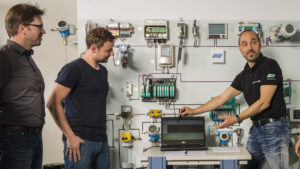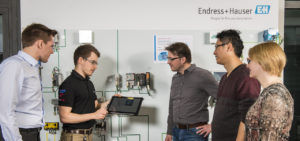 PROFIBUS first hit the market just over a quarter of a century ago. Over the years it has become one of the most widely used digital fieldbuses worldwide and is successfully operating in a wide range of applications. By the end of 2018, there were around 61 million PROFIBUS devices in operation of which 15 million were used in process automation.
PROFIBUS first hit the market just over a quarter of a century ago. Over the years it has become one of the most widely used digital fieldbuses worldwide and is successfully operating in a wide range of applications. By the end of 2018, there were around 61 million PROFIBUS devices in operation of which 15 million were used in process automation.
Nowadays, the technology comes in three different flavors:
- PROFINET, based on Ethernet, was introduced in 2006 as the natural successor to PROFIBUS DP in factory and building automation. For process automation applications, in particular, those requiring intrinsic safety, the integration of devices is still via PROFIBUS DP/PA and proxy.
- PROFIBUS DP (Distributed Peripherals) is used for the fast communication at the control level and finds application in both factory and process automation as well as hybrid applications such as those found in the food and drinks industry.
- PROFIBUS PA (Process Automation) is for device communication in the field. Here the devices are powered over the bus and thanks to the development of the FISCO model, may also be located in explosion hazardous areas such as those found in the chemical and oil & gas industries.
The successful implementation of PROFIBUS does require a higher level of know-how when compared to conventional 4-20 mA technology, but the advantages outweigh the extra effort. Users benefit from vastly fewer infrastructure costs, much smaller footprint as well as higher plant availability and more efficient maintenance.
Ensuring Competence at All Stages of a Project
 Some form of competence is always at an advantage at every stage of a PROFIBUS/PROFINET project. Preferably it is available in your own company, but it can also be provided by an experienced partner. If you are contemplating using PROFIBUS in your greenfield or brownfield project, a simple hands-on technology training before you make the decision will give you a feel of what can be achieved by the technology and where the major advantages are to be found.
Some form of competence is always at an advantage at every stage of a PROFIBUS/PROFINET project. Preferably it is available in your own company, but it can also be provided by an experienced partner. If you are contemplating using PROFIBUS in your greenfield or brownfield project, a simple hands-on technology training before you make the decision will give you a feel of what can be achieved by the technology and where the major advantages are to be found.
To get the best out of any PROFIBUS or PROFINET project, it is important to have a suitably qualified engineer in your team. Firstly, to help decide which of the systems is most appropriate to your application and secondly, to help in the selection of the best control system, network components, and instrumentation. Getting the major players, i.e. ERP, system, network component, and instrument vendors together at the earliest opportunity also paves the way for smooth project execution.
The actual design of the network is also the task of the engineer. He or she may be supported by the system and/or instrument vendor, who often have dedicated tools for optimizing and validating the network structure. In many cases, specific multi-vendor architectures have already been tested and certified, a fact that a trained engineer will be aware of.
It does not matter how good the network structure is, if its installation is faulty it will not work properly. Faulty installation is one of the major issues in PROFIBUS/PROFINET start-ups. For this reason, it pays to have a qualified installer to do the job. The installer is responsible for checking the material, installing it correctly and then checking that the network performs as it should. After the devices have been configured, the installer checks that they are all visible to the controller and, if necessary, troubleshoots the segment to a certain level. When everything works the plant can be started up.
Turn over of the plant is not the end of the competence train. In the day to day running of the plant, there are often situations where maintenance is required by one of the devices on the network. The replacement of a device has certainly become easier over the years, but there are still several pitfalls to be avoided. Hot swapping, setting the right address and downloading the configuration of the previous device are just three of the skills that are required. Similarly, how to react to NAMUR NE 107 diagnostic messages, which are now part and parcel of most PROFIBUS PA devices, is also high on the list.
These are skills that are learned by PROFIBUS/PROFINET engineers and partly installers, but it is also possible to have on-site courses for your maintenance team which focus exactly on the application you are running.
What’s Available?
 Endress+Hauser began training customers in PROFIBUS technology at the beginning of 2000 and not long afterward became the first external training center to gain PI certification. The courses are centered around the experience gained on projects and in System World, which contains and continually tests PROFIBUS and PROFINET controllers in a multi-vendor environment.
Endress+Hauser began training customers in PROFIBUS technology at the beginning of 2000 and not long afterward became the first external training center to gain PI certification. The courses are centered around the experience gained on projects and in System World, which contains and continually tests PROFIBUS and PROFINET controllers in a multi-vendor environment.
Depending upon the training course, which may last up to 3 ½ days, participants get to design, build and test their own PROFIBUS/PROFINET network. They must also configure the field devices and get them to work. For engineers the emphasis is on the design, commissioning and detailed troubleshooting of faulty networks, for installers on building a proper network installation and testing it. Here, well-known faults are simulated, and the participants must find what they are. The theory is not neglected so that the trainee emerges with a good knowledge of how everything works. The course finishes with a small examination, the successful passing of which is awarded an internationally recognized certificate.
About Endress+Hauser
Endress+Hauser training courses take place in Reinach, Switzerland or can be brought to your site practically anywhere in the world. In addition to the classroom course, webinars are regularly held on PROFIBUS/PROFINET and associated subjects, for instance, IO-Link, and half-hour so-called tech boosters show how to solve common technology issues. www.endress.com/technology-training
In 2018 nearly 2000 people were trained, evenly split between classroom and internet. Figures for 2019 are higher, but with an increasing number visiting the online sessions. If you want to be prepared for PROFIBUS or PROFINET tasks, get practical experience in designing and troubleshooting networks and be up to date on the latest trends and developments, maybe it’s time to visit a certified course at Endress+Hauser.
